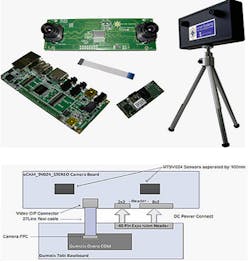3-D stereo camera reference design uses TI processor
Engineers at e-con Systems (Ballwin, MO, USA) have created a stereo vision camera reference design based on a Texas Instruments (Dallas, TX, USA) DM370 series processor.
The reference design -- code-named Capella -- includes a DM3730-based base-board, an expansion board, and a stereo camera daughter board which sports a pair of MT9V024 monochrome Aptina (San Jose, CA, USA) CMOS image sensors that can deliver synchronous parallel monochrome video at 30 frames/s.
The cameras come with pre-aligned and pre-calibrated M12 lenses on an S-mount lens holder and customers can select and calibrate the lenses for specific requirements.
The Capella reference design also has a software development kit, enabling customers to develop their own stereo vision camera-based applications.
“With the Capella reference design, e-con Systems allows customers to implement applications such as disparity mapping, human tracking, and gesture detection by implementing their own algorithms on top of our stereo camera reference design,” says Ashok Babu, president of e-con Systems.
Capella runs Linux 2.6.35 and has Ethernet, HDMI Video port, USB OTG port, and a serial interface for a Linux console. The stereo camera engine driver is V4L2 compatible and is available with an OpenCV interface patch, allowing customers to develop applications based on a V4L2 API or the OpenCV stack.
The stereo engine driver exposes three V4L2 interfaces to the application developers to capture the left, right, and combined left and right video streams. The software development kit contains sample applications using both the V4L2 interface and the OpenCV stack.
A video describing the reference design is available here.
-- by Dave Wilson, Senior Editor, Vision Systems Design
